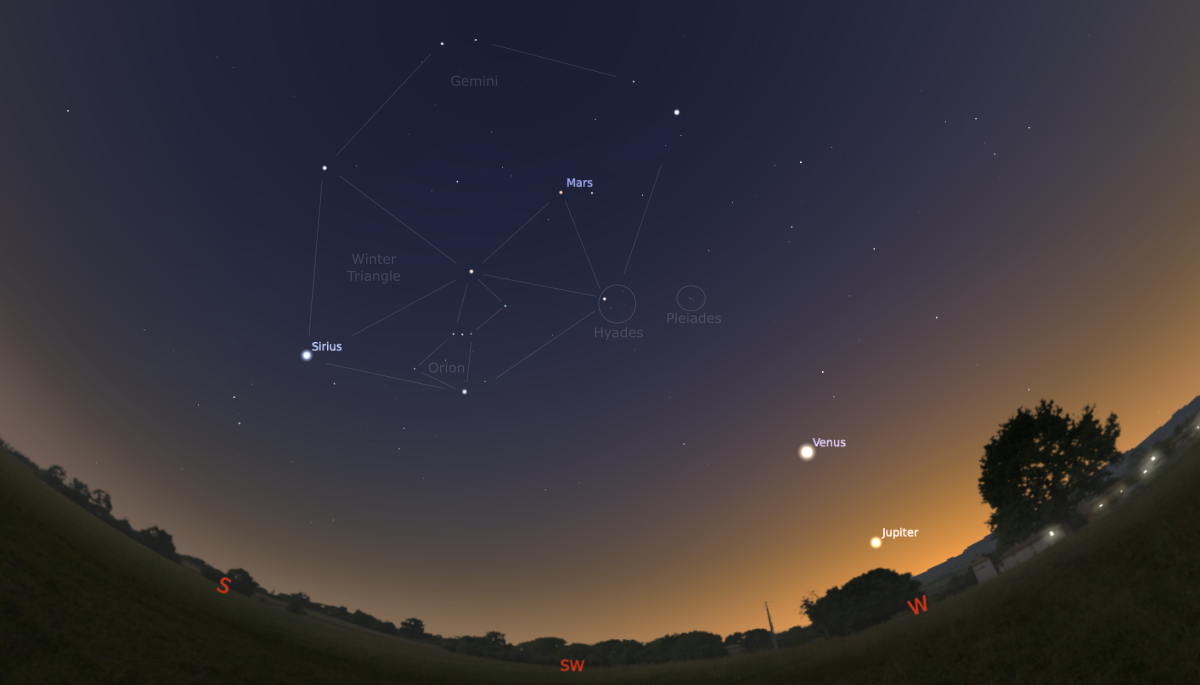Beautiful Sunsets ... and a New Website!
March 17, 2023
Hi Everyone!
This month, I have a pretty sunset scene to describe, and a big announcement of my own: Astronomy For Thinkers is now Lyncean Education! I recently combined my astronomy website with my informal science blog, added a few more science projects, added two long-form “curriculum blueprints” (including one for astronomy), and published it all as a new website. The address of the new website is https://lyncean.education. Let me know what you think!
I intend to continue publishing this astronomy newsletter, but please note that this will be the last one coming from this email address. Future editions will be sent from john at this domain. The newsletter archive and the signup form have been moved to the new website as well. Please feel free to contact me at either email address if you have any questions or comments.
The Sunset Scene
As far as astronomy news for this month, we should have some lovely sunsets to watch. You may remember that earlier this month, Venus and Jupiter passed each other in the evening skies, with Jupiter approaching the sun, and Venus climbing higher out of the sunset. If you go outdoors a little after sunset and face southwest, you will now see something like this:

(You should be able to see something similar no matter where you live on the globe, except the scene will be tilted to different angles. If you live in the Southern Hemisphere, you will have to imagine this picture rotated to the right around the western horizon, so that the stars and planets lie to the right of the sunset instead of to the left, and you will have to face northwest instead of southwest. Incidentally ... why is this the case? If you were in doubt about the shape of the Earth, here we have another clue that it is spherical. Traveling over a curved surface makes us see outer space from different angles.)
You can still see the two brightest planets over the sunset, although now Venus is the higher one, and Jupiter sets shortly after the sun. If you imagine the sun below the horizon, you will notice that it lines up roughly with Venus and Jupiter. If you use your imagination to extend that common arc up among the constellations, you will pass through the “Golden Gate of the Ecliptic” (between the Pleiades and the Hyades), and you will come to a reddish “wandering star” ... namely Mars. The sun, the moon, and all of the planets move around among the constellations, but they are always somewhere along this circular “planet path.” It is as if they are all moving around within the same plane in space, and this ring around us in the sky is our view from inside that plane.
After passing through the “Golden Gate” (which is officially part of Taurus), the planet path crosses a particularly bright region of stars, containing some of the brightest stars in the sky. (It actually contains the single brightest star in the sky, if you don't count the sun or the “wandering stars” ... namely Sirius.) This is the “Winter Hexagon” or “Winter Circle,” and this month will be our last chance to see it in its entirety before it sinks into the sunset and finally disappears from the evening skies for the season. You might notice a particularly nice equilateral triangle to the left of Orion, with Sirius forming the southerly vertex. That's the “Winter Triangle.” You might also notice that, coincidentally, Mars forms a reasonably nice triangle with two other reddish stars at the moment. The reddish star forming Orion's right shoulder is Betelgeuse, and the brightest star in the reddish cluster of the Hyades (which also forms the horns of Taurus), is Aldebaran. Perhaps by observing the shape of this triangle night after night, you can track the motion of the red “wandering star.”
Saturn is currently a lonely, solitary planet decorating the sunrises. Mercury will be rising and joining the sunset scene later this month, but it probably won't be high enough or bright enough to see until April. If you want to go “Mercury hunting” over the sunsets, your best chance will be within a week or so of “greatest elongation,” which will happen on April 11. After that, speedy Mercury will turn around and pop back down into the sunset. The new moon this month will happen on the 21st, and a couple of days after that, look for the beautiful crescent moon to climb out of the sunset, and pass along the “planet path” towards the opposite horizon.
That's all for now. Enjoy your evening walks!
John